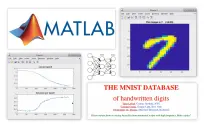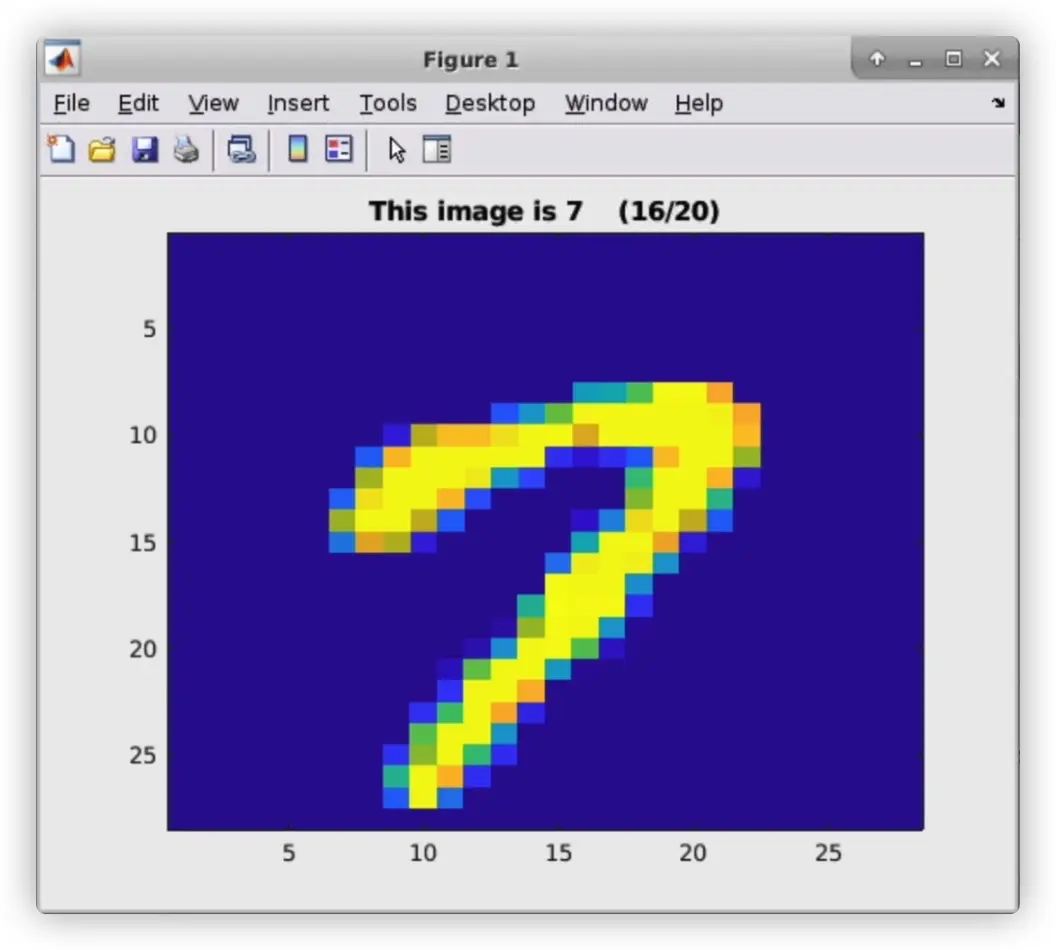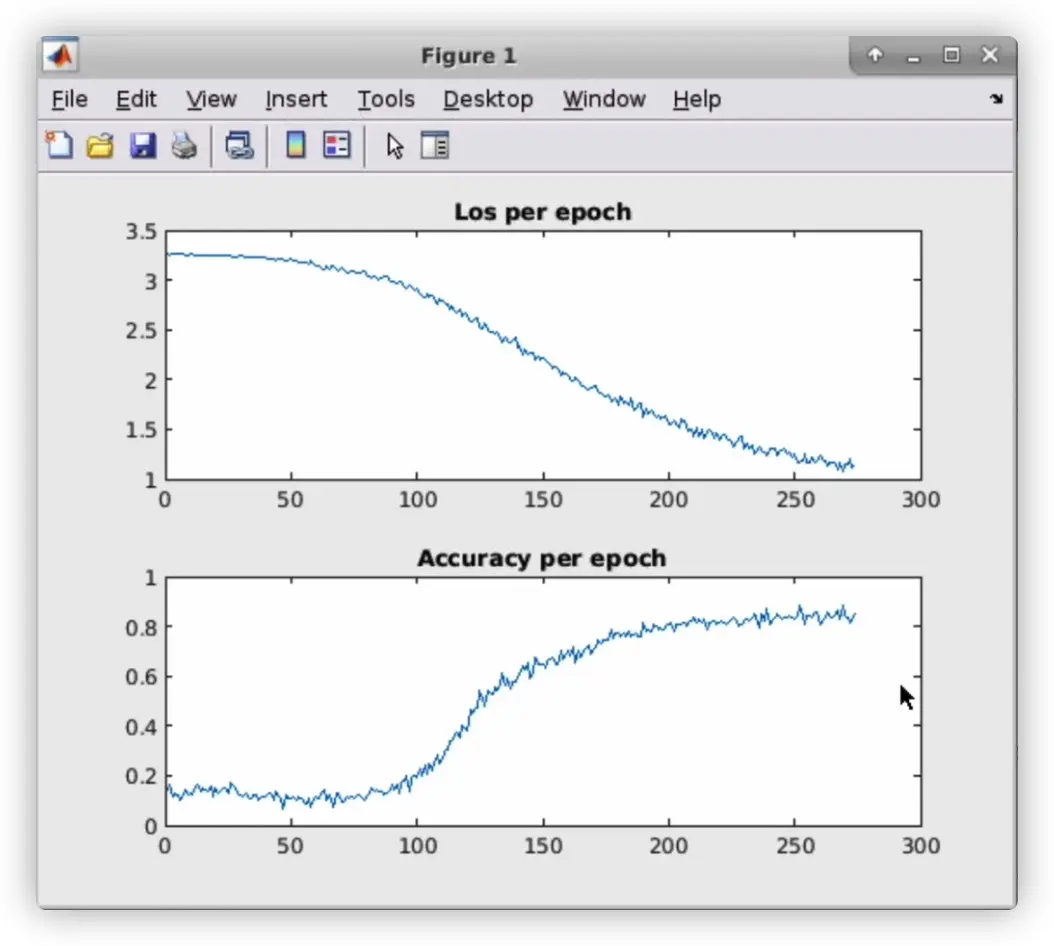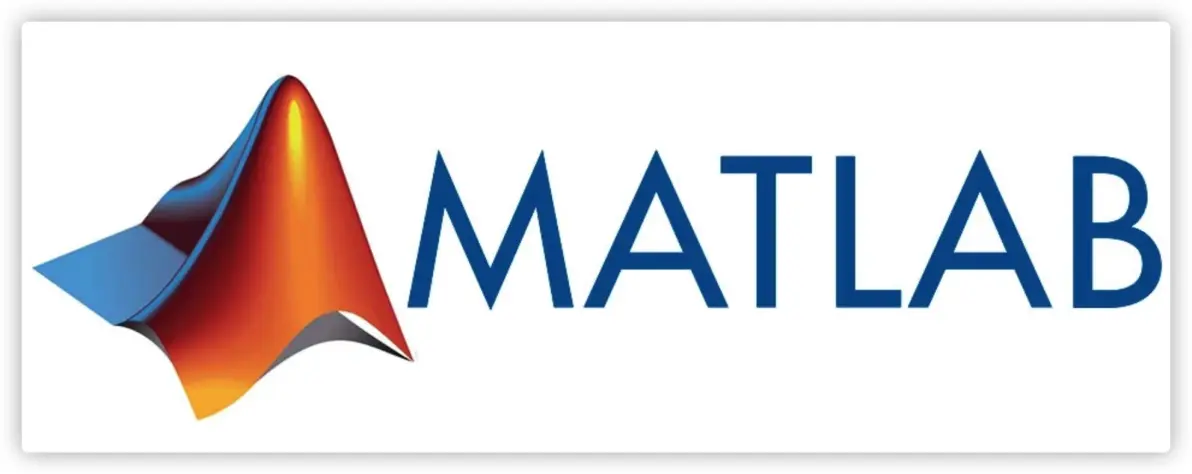产品
代码讲解视频:

相关网站:MNIST数据集(http://yann.lecun.com/exdb/mnist/)

MNIST网站截图

运行界面1-部分数据展示

运行界面2-学习过程
运行界面Part1-部分数据展示
说明:将MNIST数据集网站的4个文件解压后放到源代码路径下即可
源代码:(工地英语注释QwQ)
clear;
% data read
fImg = fopen('train-images.idx3-ubyte');
offset = fseek(fImg,0,'bof');
magicNumber = swapbytes(uint32(fread(fImg,1,'uint32')));
dataNumber = swapbytes(uint32(fread(fImg,1,'uint32')));
rowN = swapbytes(uint32(fread(fImg,1,'uint32')));
colN = swapbytes(uint32(fread(fImg,1,'uint32')));
%%
% get all train data
dataImg = double(swapbytes(uint8(fread(fImg,[rowN*colN,dataNumber],'uint8'))));
fclose(fImg);
fLab = fopen('train-labels.idx1-ubyte');
offset = fseek(fLab,8,'bof');
dataLab = swapbytes(uint8(fread(fLab,[dataNumber],'uint8')));
dataLabMat = zeros(10,dataNumber);
fclose(fLab);
for i=1:dataNumber
dataLabMat(uint32(dataLab(i))+i*10-9) = 1;
end
%%
% show MNIST handwriting image
%
for i=1:10
% imshow(show)
imagesc(reshape(dataImg(:,i),[rowN,colN]).')
title(['This image is ',num2str(dataLab(i)),' (',num2str(i),'/10)'])
pause(0.5);
end
%}
%%
% NeuralNets modeling 1 -random initialize
% layerN is the modle definition, which tells you homany units per layer
layerN = [rowN*colN 64 16 10];
w1 = double((rand(layerN(1),layerN(2))-0.5)/512);
b1 = double((rand(layerN(2),1)-0.5)/512);
w2 = double((rand(layerN(2),layerN(3))-0.5)/4);
b2 = double((rand(layerN(3),1)-0.5)/4);
w3 = double((rand(layerN(3),layerN(4))-0.5)/16);
b3 = double((rand(layerN(4),1)-0.5)/16);
%%
% learning loop
lRate = 0.0004; % acts very bad when it is lager than 0.0004
epoch = 1000; % too lagert may over-trained or have NaN/Inf in model, less than 4k is safe
epochSize = 500; % this can smooth the training process but SLOW it down
los = [];
accuracy = [];
title('Training start!')
pause(0);
tic;
for i=1:epoch
% data select
randomSelect = randi(dataNumber,1,epochSize);
epochImg = dataImg(:,randomSelect);
epochLab = dataLabMat(:,randomSelect);
% model calculate
z1 = double(w1.'*epochImg + b1);
a1 = double(max(z1,0.01*z1));% Leaky ReLU
z2 = double(w2.'*z1 + b2);
a2 = double(max(z2,0.01*z2));
z3 = double(w3.'*z2 + b3);
a30 = double(min(exp(z3),10e300));
a3 = double(a30./sum(a30));
% grident calculate
dz3 = double(a3-epochLab);
dw3 = double(a2*(dz3.')/epochSize);
db3 = double(sum(dz3.').'/epochSize);
da2 = double(w3*dz3);
dg2 = double(z2);
dg2(find(z2>=0)) = double(1);
dg2(find(z2<2)) = double(0.01);
dz2 = double(da2.*dg2);
dw2 = double(a1*(dz2.')/epochSize);
db2 = double(sum( dz2.' ).'/epochSize);
da1 = double(w2*dz2);
dg1 = double(z1);
dg1(find(z1>= 0)) = double(1);
dg1(find(z1<0)) = double(0.01);
dz1 = double(da1.*dg1);
dw1 = double(epochImg*(dz1.')/epochSize);
db1 = double(sum( dz1.').'/epochSize);
% gradent decent
w1 = w1-dw1*lRate;
b1 = b1-db1*lRate;
w2 = w2-dw2*lRate;
b2 = b2-db2*lRate;
w3 = w3-dw3*lRate;
b3 = b3-db3*lRate;
% los & accuracy calculate
los(i) = mean(sum(-log(a3).*epochLab-log(1-a3).*(1-epochLab)));
[m,p] = max(a3);
modelAns = zeros(10,epochSize);
for j=1:epochSize
modelAns(p(j)+j*10-10) = 1;
end
accuracy(i) = mean(sum(modelAns.*epochLab));
% gradualy slow down mode
lRate = lRate*(1-0.0005);
%{
subplot(2,1,1)
plot(1:i,los)
title('Los per epoch')
subplot(2,1,2)
plot(1:i,accuracy)
title('Accuracy per epoch')
pause(0);
%}
end
toc
subplot(2,1,1)
plot(1:epoch,los)
title('Los per epoch')
subplot(2,1,2)
plot(1:epoch,accuracy)
title('Accuracy per epoch')
%%
% test set
% data read
fImg = fopen('t10k-images.idx3-ubyte');
offset = fseek(fImg,0,'bof');
magicNumber = swapbytes(uint32(fread(fImg,1,'uint32')));
testNumber = swapbytes(uint32(fread(fImg,1,'uint32')));
rowN = swapbytes(uint32(fread(fImg,1,'uint32')));
colN = swapbytes(uint32(fread(fImg,1,'uint32')));
testImg = double(swapbytes(uint8(fread(fImg,[rowN*colN,testNumber],'uint8'))));
fclose(fImg);
fLab = fopen('t10k-labels.idx1-ubyte');
offset = fseek(fLab,8,'bof');
testLab = swapbytes(uint8(fread(fLab,[testNumber],'uint8')));
testLabMat = zeros(10,testNumber);
fclose(fLab);
for i=1:testNumber
testLabMat(uint32(testLab(i))+i*10-9) = 1;
end
%%
% testing
z1 = double(w1.'*testImg + b1);
a1 = double(max(z1,0.01*z1));
z2 = double(w2.'*z1 + b2);
a2 = double(max(z2,0.01*z2));
z3 = double(w3.'*z2 + b3);
a30 = double(min(exp(z3),10e300));
a3 = double(a30./sum(a30));
%%
% accuracy
[m,p] = max(a3);
modelAns = zeros(10,testNumber);
for j=1:testNumber
modelAns(p(j)+j*10-10) = 1;
end
teatAccu = mean(sum(modelAns.*testLabMat))

MATLAB